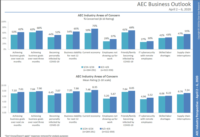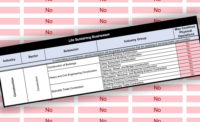Construction employees had a slightly more positive outlook ahead for the sector, according to 416 respondents in a broad industry survey of COVID-19 impact conducted from April 16-20. But most still expressed strong concern for the economy, their employers' ability to achieve company goals over the next three to six months, and business stability risk into next year.
Despite the marginally improved outlook, project delays and cancellations continue to grow, said the latest survey by Clear Seas Research and BNP Media. The latter also is the parent company of ENR.
For the first time, fewer than half of both active and planned projects were on schedule, said survey participants. An average of 37% of active projects were delayed and 16% have been cancelled, representing a 2% increase from the previous survey conducted between April 2 and April 6.
Cancellations of planned projects rose to 15%, a 3% hike over the previous survey, with delayed projects up 2% to 41%. Nearly all respondents, 92%, said activity would return to normal in 12 months or less, with 21% expecting that outcome within six months.
[For ENR’s latest coverage of the impacts of the COVID-19 pandemic, click here]
The majority of respondents say their employers continue to promote social distancing—enabling or requiring staff to work from home, although only 44% have had to provide employees with personal protective equipment (PPE).
Some companies are rethinking how they will conduct business when activity returns to normal, respondents said. "We may allow more employees to continue working remotely from now on as the company is performing well in this new mode," said one.
The number of firms anticipating layoffs and furloughs over the next three months declined by around 15%, said those queried, with the number indicating they would be ready to hire previously laid off workers in the next three months rising to 17% in the current survey, from 11% in the survey in late March. Respondents noting that their employers would hire new staff in the same time frame rose to 12% from 7%.
While 30% of respondents in the previous survey indicated plans to apply for small business stimulus loans through the Paycheck Protection Program, 57% in this survey say they have done so. Of those, 19% have been approved and received funds; 25% have been approved and are waiting to receive funds. The majority, 56%, still await approval.
There may be some good news for the latter. The $310-billion additional infusion of funds into the program—whose reserves were depleted in less than two weeks—was signed into law April 24 and will likely be allocated to applicants already in the queue.
Respondents noted that during the pandemic, marketing effort, skillbuilding and work on non-billable or lower priority projects were activities most frequently boosted.
As a communication technology, videoconferencing has taken off like wildfire for respondents with teams working remotely.
In March, only 3% said they used video chat for work. In the April 16-20 survey, almost half were using video conferencing. There were similar increases in use of collaboration tech such as Slack, Teams, Hangouts and Jabber in the past month.
Even the old-fashioned telephone is making a comeback. In March, only 3% of respondents said they had encouraged phone calls as a way to communicate quickly with staff working remotely. In the latest survey, that rose to 60%.
As with the prior surveys, "the information contained within this report represents moments in time," said Beth Surowiec, executive director of Clear Seas Research/BNP Media, "It provides the collective voice of industry decisionmakers, influencers and contributors, and offers a unique understanding of where businesses are today."
One respondent offered words of encouragement to the industry: "We all are in this together and I think we need to help other people in need, and give a positive message."







Post a comment to this article
Report Abusive Comment